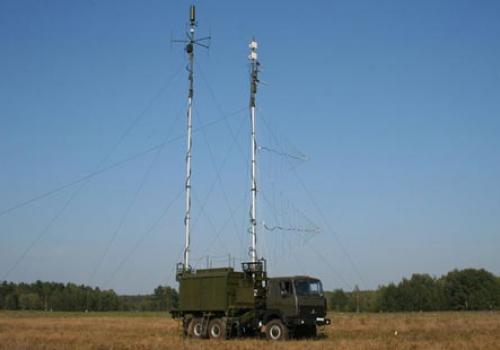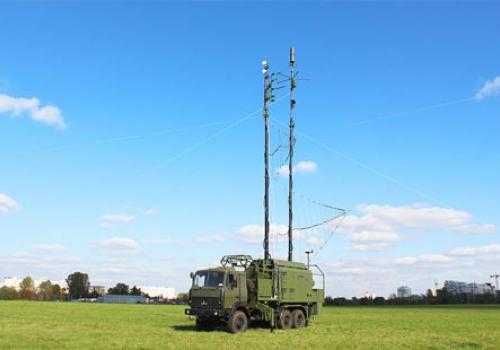Mobile jamming station of VHF band "Groza"
Designation of radio reconnaissance stations:
automatic search, detection, determination of bearings and coordinates (while operating as mated pair), technical analysis of emissions of VHF ground and aerial radio communications operating at fixed frequencies, as well as in the mode of pre-programed radio frequency hopping with the speed up to 1000 times per second in the 30 MHz band;
reception and transmission of information to the control center.
Designation of radio suppression stations: radio suppression of VHF ground, aviation and satellite radio communication links:
up to 20 lines operating at fixed frequencies quasi-simultaneously;
one link operating in the pre-programed radio frequency hopping mode with the speed up to 500 times per second in the 30 MHz band.
Capabilities
• Control of radio electronic situation within the range of radio visibility, i.e. up to 40-50 km for ground targets and up to 320 km for air targets (with a flight altitude of more than 10,000 m); technical analysis and signals interception (auditory control) within the range of 30 MHz - 3 GHz.
• Search, detection and direction finding of new sources of radio emission in predetermined parts of the frequency range 30-3000 MHz.
• Measurement of signals parameters of detected radio emission sources.
• Monitoring the operation of known emission sources put for observation.
• Disclosure of the modes of emission sources operating at fixed frequencies and in the frequency hopping mode, with the selection of individual sources within the frequency-bearing panorama.
• Assignment of frequencies for maintaining radio suppression: automatically, by the operator or by command from the control point.
• Automatic control of the operation of radio emission sources predetermined for suppression.
• Simultaneous emission of interference signals up to 20 selected frequencies, taking into account priority.
• Generation of interference signals corresponding to the type of modulation of the monitored signals.
• Suppression of a single network with pre-programed radio frequency hopping.
• Creation and transmission of reports on the results of control and suppression to the control point.
• Registration of signals at the output of the auditory control receiver.
• Technical analysis of signals of radio emission sources on a time scale close to real.
• Determination of coordinates of the location of radio emission sources with the display on the map when two stations operate in the mated pair.
• Control of parameters and modes of operation, collection of information from the secondary station of the mated pair to the primary station.
• Automated data processing and documentation.
Main technical characteristics:
| № |
Characteristic |
Value |
| 1 |
Radio reconnaissance frequency range |
30-3000 MHz |
| 2 |
Jamming radio frequency range |
30-3000 MHz |
| 3 |
Sub-ranges of radio transmitter letters and output power while operating with the agreed load of 50 Ohm: |
|
|
- 1 letter within the sub-range from 30 up to 50 MHz |
not less than 1000 W |
|
|
- 2 letter within the sub-range from 50 up to 90 MHz |
not less than 1000 W |
|
|
- 3 letter within the sub-range from 90 up to 160 MHz |
not less than 1000 W |
|
|
- 4 letter within the sub-range from 160 up to 290 MHz |
not less than 1000 W |
|
|
- 5 letter within the sub-range from 290 up to 512 MHz |
not less than 1000 W |
|
|
- 6 letter within the sub-range from 512 up to 860 MHz |
not less than 800 W |
|
|
- 7 letter within the sub-range from 860 up to 1215 MHz |
not less than 700 W at frequencies from 860 up to 1000 MHz, not less than 200 W at frequencies from 1000 up to 1215 MHz |
|
|
- 8 letter within the sub-range from 1215 up to 2000 MHz |
not less than 35 W |
|
|
- 9 letter within the sub-range from 2000 up to 3000 MHz |
not less than 35 W |
|
| 4 |
Mean-square error of direction finding, not more than |
2 ° |
| 5 |
Threshold sensitivity of radio receiver (in the signal band of 100 Hz and signal/noise ratio of 10 dB), not worse than: |
-110 dBm |
| 6 |
Peak sensitivity of detection/direction finding device (in simultaneous scanning bandwidth of 30 MHz), not worse than: |
-100 dBm |
| 7 |
Frequency stability of reference generator of detection/direction finding device, not worse than |
3 х 10-11 |
| 8 |
Minimum duration of detection signal |
1 ms |
| 9 |
Dynamic range of radio receiver in the two-signal mode while mismatch between frequencies of 25 kHz, not less than |
60 dB |
| 10 |
Dynamic range of radio receiver in the one-signal mode, not less than |
100 dB |
| 11 |
Simultaneous scanning bandwidth (variable, maximum value), not less than: |
150 MHz |
| 12 |
Simultaneoous scanning bandwidth in multi signal direction finding, not less than: |
30 MHz |
| 13 |
Scanning speed by frequency (in simultaneous scanning bandwidth of 30 MHz), not less than: |
25 GHz/s |
| 14 |
Frequency hopping step in technical analysis mode, not worse than |
1 Hz |
| 15 |
Accuracy of frequency detection in the detection and direction finding modes (within simultaneous swath of 30 MHz), not worse than |
200 Hz |
| 16 |
Quantity of fixed-frequency links jammed simultaneously by any of radio transmitter letter |
up to 4 |
| 17 |
Quantity of fixed-frequency links jammed simultaneously in 5 letters of radio transmitter |
up to 20 |
| 18 |
Level of high harmonic components of the jamming signal, not more than |
minus 60 dB |
| 19 |
Detection of pre-programmed radio frequency hopping, maximum number of hops |
1000 hops/s |
| 20 |
Response time while generating aimed interferences at fixed controlled frequencies within operational letter of the power amplifier, not more than |
12 ms |
| 21 |
Response time while generating interferences to radio communication links, operating in the pre-programmed radio frequency hopping in the band up to 20 MHz, not more than |
0,8 ms |
| 22 |
Memory (storage) of values of suppressing frequencies, no less than: |
|
|
- operating at fixed frequencies |
40 |
|
|
- operating in the pre-programmed radio frequency hopping mode |
800 |
|
| 23 |
Types of generated interferences: |
|
|
- aimed frequency modulated by noise |
Yes |
|
|
- aimed phase-manipulated |
Yes |
|
|
- aimed frequency manipulated |
Yes |
|
|
- jamming noise in the band up to 20-100 MHz (depending on the letter) |
Yes |
|
|
- other types of interferences at the Customer’s request |
Yes |
|
| 24 |
Frequency ranges of beam transmitting antennas: |
|
|
- 1 and 3 letters |
from 30 up to 50 MHz and from 90 up to 160 MHz |
|
|
- 2 and 4 letters |
from 50 up to 90 MHz and from 160 up to 290 MHz |
|
|
- 5 letter |
from 290 up to 512 MHz |
|
|
- 6 letter |
from 512 up to 860 MHz |
|
|
- 7 letter |
from 860 up to 1215 MHz |
|
|
- 8 letter |
from 1215 up to 2000 MHz |
|
|
- 9 letter |
from 2000 up to 3000 MHz |
|
| 25 |
Transmission antenna gain: |
|
|
- within the range from 30 up to 290 MHz not less than |
4,5 dB |
|
|
- within the range from 290 up to 2700 MHz not less than |
6 dB |
|
| 26 |
Possibility of automatic turn of transmitting antennas of frequency range from 290 up to 2700 MHz |
yes |
| 27 |
Station setup and teardown time by 4 persons, not more than |
45 min |
| 28 |
Station power supply: |
|
|
- industrial network of three-phaze AC |
380 V ± 10 %, 50 Hz |
|
|
- diesel generator of three-phase AC of 380 V 50 Hz |
two diesel generator by 16 kW |
|
| 29 |
Three chassis |
MAZ-631705 |
| 30 |
Operating temperature range for equipment operating outdoors |
From minus 40 up to plus 55 ºC |
| 31 |
Operating temperature range for equipment operating indoors |
From plus 5 up to plus 40 ºC |
Main features
• Correlation-interferometric method of direction finding, which provides detection and direction finding of pulse and pre-programed radio frequency hopping signals of duration of 0.8 ms.
• Measurement of parameters of radio signals.
• Automatic determination of coordinates of radio emission sources when there are two jamming stations in the mated pair.
• Use of modern technologies of digital synthesis while generating jamming signals that provide radio suppression of communication links in the pre-programed radio frequency hopping mode up to 500 hops per second.
• Radio transmitter letter power up to 1 kW. Possibility of simultaneous operation for the emission of up to 5 letters and simultaneous suppression of up to 20 radio links at fixed frequencies.
• Use of quickly erected antenna mast devices provides short setup and teardown time of the station.



